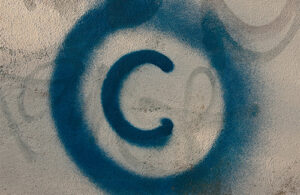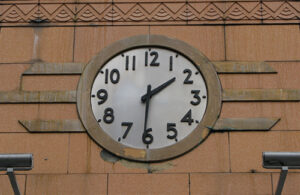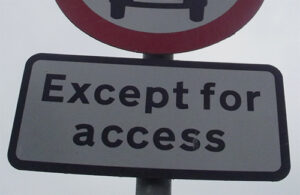Associations and institutions are welcome to apply to become members of the ALCC.
If you are new to copyright or looking for a refresher our Short introduction to copyright is the place to start.

Copyright is everywhere!
Photo: Horia Varlan. CC BY 2.0. Full attribution information below.
In brief, copyright covers a range of material such as literature, visual arts and films. Copyright owners enjoy a range of rights over that content, including the ability to allow or restrict reuse of the content. Material can be reused with the permission of the copyright owner, or, in some circumstances, by relying on an exception to copyright.
For libraries, archives and other cultural collections this means much of the content in their collections are likely to be within the scope of what is protected by copyright, and, for as long as the material is protected, many of the uses they might want to make of that material will typically be protected by copyright.
What is copyright?
Copyright is an area of law that gives creators a bundle of rights to control how others use their creations. While these rights vary depending of the type of material in question, broadly a copyright owner can prevent uses that would infringe copyright in their material and they can authorise use of the material by another party. When giving other parties permission to reuse material they have the right to receive remuneration for the use of the material.
It is one of the categories of ‘intellectual property law’, along with patents, trade marks and designs law. While patents protect inventions and trade marks protect brand names, copyright protects creative works like books, films, music and art.
What is the purpose of copyright?

Copyright is a balance between the incentive to create and the sharing of knowledge.
Photo: Andy / Andrew Fogg. CC BY 2.0. Full attribution information below.
If you ask most people they will tell you copyright is about protecting creative works. That is true. And this is a good starting point for understanding copyright. But there is more to it than that.
Copyright is designed to incentivise the creation of new content and to provide a legal framework for the management of that content. It is specifically designed to facilitate the commercial exploitation of creativity.
But copyright has a greater purpose than just making money. Copyright is meant to provide a balance between incentivising creativity by allowing authors to make money from their creations while also encouraging the dissemination of knowledge to the public through publication and sharing. Copyright should be a win–win.
Sources of copyright law
The modern copyright system plays out at four levels:
- Internationally through treaties and trade agreements (international level).
- Domestically through legislation and case law (jurisdictional/country level).
- Organisationally through compliance and industry practice (industry level).
- Normatively through community and behavioural norms (community level).
Each tier is expanded on in our page on the sources of copyright law.
Copyright Act 1968
In Australia, copyright law is set out in the Copyright Act 1968 (Cth). It outlines many aspects of copyright including:
- what is protected by copyright
- what rights make up copyright protection
- how long copyright protection lasts
- what constitutes an infringement of copyright
- what does not constitute an infringement of copyright
Over its lifetime it has had many amendments including extending the safe harbour scheme to include educational, cultural and disability organisations and introducing moral rights.
The Copyright Act, as well as associated copyright regulations, copyright policy and international copyright issues are managed by the Department of Infrastructure, Transport, Regional Development and Communications.
Material protected by copyright
Broadly, copyright protects:
- ‘Works’, including literary works (books, magazine articles, etc), dramatic works (theatre and dance), music and artistic works (paintings, drawings, photographs, etc).
- ‘Subject matter other than works’ which includes sound recordings, films, broadcasts and published editions of works.
While many of these categories seem obvious, some of the things that they include might surprise you. Copyright can cover items you may not ordinarily think of, like databases, computer software and costumes. If you are unsure if something is protected by copyright, it’s usually best to assume it is.
Our information on material protected by copyright provides a more comprehensive look at copyright protected content.
Requirements to gain copyright protection
Copyright protection in Australia is free and automatic as soon as content is in a material form (such as the words of a poem being written down or a song is recorded). It does not need to be registered, applied for or paid for.
To be protected content must be a work or other subject matter. In order to be protected, all literary, dramatic, musical and artistic works must be:
- An expression, not an idea.
- In a material form.
- Original.
- Made by a human author.
For more about what these requirements mean see our page on the requirements content must meet to gain copyright protection.
Rights in copyright
The main group of rights in copyright are called economic rights.
Owners of literary, dramatic and musical works have the right to reproduce the work, publish it, communicate it online, adapt it and perform it in public. Owners of artistic works have the right to reproduce, publish and communicate. The owners of sound recordings and films can make a copy of the recording or film, play the recording or film in public and communicate the recording or film online.
Creators also have moral rights over their works, which protect their right to accurate attribution and to not have the work treated badly. And performers have rights over their performances, such as to stop bootlegging. Our information on the rights in copyright: Rights in copyright provides a more comprehensive overview of the economic and other rights in copyright.
Duration of copyright

Copyright protection is important, but so is the public domain. That’s why copyright protection has a time limit.
Photo: Helder Mira. CC BY 2.0. Full attribution information below.
The rights provided by copyright only last for a certain amount of time, and the duration of copyright depends on the type of material. For example:
- Works are generally protected for the life of the creator plus 70 years, or if you don’t know who the author is, 70 years from when they were made public or created.
- Sound recordings and films are protected for 70 years from when they were made public, or if they haven’t been made public, from when they were created.
However, the full rules of copyright duration are complex, with the rules changing depending on when material was created, the type of material it is, who the creator was and how much we know about them. Our more detailed information on the duration of copyright looks at these situations. We also recommend the Department of Communications and the Arts’ information on their website about the ‘Duration of copyright’, in particular their tables that help to clarify the applicable duration rules.
Ownership of copyright
Generally speaking, for a literary, dramatic, musical or artistic work the author is the owner of copyright: Authors of literary, dramatic, musical and artistic works in Ownership of copyright in the work. The maker of other subject-matter is the copyright owner: Makers of other subject-matter in Ownership of copyright (except for published editions, for which the publisher is the copyright owner).
There are exceptions to these general rules however. Ownership of copyright can be more complicated depending on the parties involved. We have a page that provides a more comprehensive look at who is the owner of copyright.
Exceptions to copyright

Exceptions are an important part of the copyright system.
Photo: Elliott Brown. CC BY 2.0. Full attribution information below.
If you don’t have permission to use copyright protected material there may be an exception that allows use without infringement. The Copyright Act includes a number of exceptions to copyright.
The most well-known group of copyright exceptions are referred to as fair dealing. A dealing with a literary, dramatic, musical or artistic work, with an adaptation of a literary, dramatic or musical work or with audio-visual items is not an infringement of copyright where the dealing is fair and is for the purpose of:
- Research or study.
- Criticism or review.
- Parody or satire.
- Reporting of news.
- Judicial proceedings or professional advice.
- Access by persons with a disability.
There are also a number of exceptions for libraries and archives, including:
- Preservation of the collection.
- Reproducing and communicating works for users – i.e. document supply.
- Reproducing and communicating works for other libraries or archives – i.e. interlibrary loan.
- Onsite Research.
- Administration of the collection.
- Publication of unpublished works.
There are nearly 90 other exceptions, including for:
- Private copying – both format-shifting and time-shifting. Format-shifting allows you to copy certain types of material that you own for private and domestic use into a different ‘format’ – e.g. copying a CD to MP3 format. The time-shifting exception allows you to record a television or radio broadcast to watch or listen to it later.
- Filming, photographing, drawing or painting sculptures in public places and buildings.
- Public recitation of a “reasonable” part of a literary work.
- Incidental filming of an artwork.
- Temporary reproduction as part of technical processes.
We have a page that provides a more comprehensive look at exceptions to copyright.
